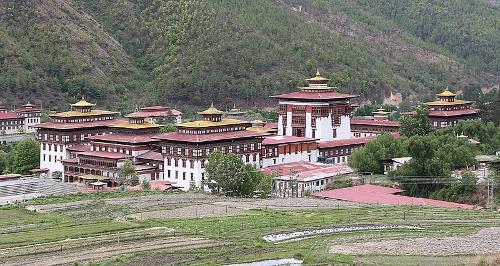BHUTAN
Society

Society
Society
State structure
 Bhutan Parliament BuildingPhoto: Bernard Gagnon CC 4.0 International no changhes made
Bhutan Parliament BuildingPhoto: Bernard Gagnon CC 4.0 International no changhes made
The king (Druk Gyalpo) of Bhutan is also the (hereditary) head of state, and has ruled the constitutional monarchy since July 18, 2008, before that Bhutan was an absolute monarchy. The king is the symbol of the unity between state and people of Bhutan. The king is furthermore the protector of all religions in Bhutan, appointed senior officials and is commander of the Bhutanese Armed Forces. The king can only be succeeded by a child from a valid marriage. According to the constitution, the king is obliged to resign at the age of 65 and is then succeeded by the crown prince or crown princess, provided he is at least 21 years old. If the successor is not yet 21 years old, a regent observes.
The government building in the capital, Thimphu, is home to the 25 members of the upper house, the 'Gyelyong Tshogd' and the 47 members of the lower house or National Assembly (Tshogdu). The upper house has apolitical, non-partisan members, five of whom are elected by the king. The remaining twenty upper house members are elected through each of the 20 Bhutanese districts or 'dzongkhags'. The 47 members of the lower house, who do belong to a political party, are elected from 47 electoral districts. Both the members of the lower house and the upper house are elected for a period of five years. The constitution states that the national assembly may consist of a maximum of 55 people.
The party with the majority in parliament forms the government, the rest of the parties are in the opposition. The Prime Minister of Bhutan is always the leader of the ruling party in the lower house. The king, in consultation with the prime minister, nominates the candidates for a squad of ministers or 'Lhengye Zhungtshog', who are chosen from among the members of the lower house. After approval by parliament, the minsters can run their country for five years. In theory, a two-thirds majority of parliament can depose the king.
Constituencies overview
| constituency | district | constituency | district | constituency | district |
| Chhoekhor Tang | Bumthang | Lamgong Wangchang | Paro | North Thimphu | Thimphu |
| Chhumig Ura | Bumthang | Khar Yurung | Pema Gatshel | South Thimphu | Thimphu |
| Bongo Chapchha | Chhukha | Nanong Shumar | Pema Gatshel | Bartsham Shongphu | Trashigang |
| Phuentshogling | Chhukha | Nganglam | Pema Gatshel | Kanglung Samkhar Udzorong | Trashigang |
| Drukjeygang Tseza | Dagana | Kabisa Talog | Punakha | Radhi Sagteng | Trashigang |
| Lhamoi Dzingkha Tashiding | Dagana | Lingmukha Toedwang | Punakha | Thrimshing | Trashigang |
| Khamaed Lunana | Gasa | Dewathang Gomdar | Samdrup Jongkhar | Wamrong | Trashigang |
| Khatoed Laya | Gasa | Jomotshangkha Martshala | Samdrup Jongkhar | Draagteng Langthil | Trongsa |
| Bji Kar Tshog Uesu | Haa | Dophuchen Tading | Samtse | Nubi Tangsibji | Trongsa |
| Sombaykha | Haa | Phuentshogpelri Samtse | Samtse | Kilkhorthang Mendrelgang | Tsirang |
| Gangzur Minjey | Lhuentse | Tashichhoeling | Samtse | Sergithang Tsirang Toed | Tsirang |
| Maenbi Tsaenkhar | Lhuentse | Ugyentse Yoeseltse | Samtse | Athang Thedtsho | Wangdue Phodrang |
| Dramedtse Ngatshang | Monggar | Gelegphu | Sarpang | Nyishog Saephu | Wangdue Phodrang |
| Kengkhar Weringla | Monggar | Shompangkha | Sarpang | Bardo Trong | Zhemgang |
| Monggar | Monggar | Boomdeling Jamkhar | Tashi Yangtse | Panbang | Zhemgang |
| Dokar Sharpa | Paro | Khamdang Ramjar | Tashi Yangtse |
The twenty districts or 'dzongkhag' further consist of 205 'gewogs', a number of towns and cities, and 'thromdes', the third administrative layer in Bhutan. The districts are governed by a body called 'Dzongkhak Tshokdu'. The current political situation is described in the chapter history.
Sources
BBC - Country Profiles
Brown, Lindsay / Bhutan
Lonely Planet
CIA - World Factbook
Dorje, Gyurme / Bhutan Handbook
Footprint
Elmar Landeninformatie
Jordans, Bart / Bhutan : a trekker's guide
Cicerone
Pommaret, Françoise / Bhutan : Himalayan mountain kingdom
Odyssey
Te gast in Bhutan
Informatie Verre Reizen
Copyright: Team The World of Info